The Definitive Skin Color Chart: A Guide to All Skin Tones & Complexions

Key Takeaways
- Employ a skin complexion chart to view tones and undertones at a glance and select foundation, cosmetics and clothing that flatter your natural coloring. Verify actual swatches in natural light to prevent shade mistakes.
- Depending on the Fitzpatrick skin phototype scale for your skin's reaction to sun and to inform SPF selections and dermatology care! Begin by your burn and tan history to determine your type I to VI.
- Products matched to undertones to keep ashy, gray or too warm results. Develop your own chart of undertone, shade matches and wear tests so you can replicate successes.
- Delve into complementary charts for more depth like the Baumann skin type indicator and seasonal color guides. Pair them with a skin undertones chart to further hone your makeup and fashion color choices.
- Formulate a regimen that complements your skin type and undertone. Defend daily with broad spectrum SPF and go after concerns like sensitivity, oil control, or hyperpigmentation.
- Look out for tech-powered advances such as apps and universal shade finders that enhance real-time matching. Anticipate expanded, more focused palettes that simplify the search for your perfect tone and undertone.
💫 Take Color Analysis Quiz
Ready to discover your complete color profile? Our comprehensive color analysis quiz will identify your skin undertones, seasonal type, and perfect color palette for makeup, hair, and wardrobe choices.
Take Color Analysis Quiz →A skin complexion chart is a guide that categorizes skin tone into obvious ranges to assist in matching products, shades and sun care.
Designed for practical application, it connects undertones—cool, warm, neutral—with depth, from fair to deep. Most charts cite the Fitzpatrick scale, which rates UV response from I to VI.
Used by dermatology, beauty and photography, charts cut guesswork. To root out choices, the upcoming sections display types, ways to interpret them, and easy methods to examine undertone.
📚 Recent Articles
What is a skin complexion chart?
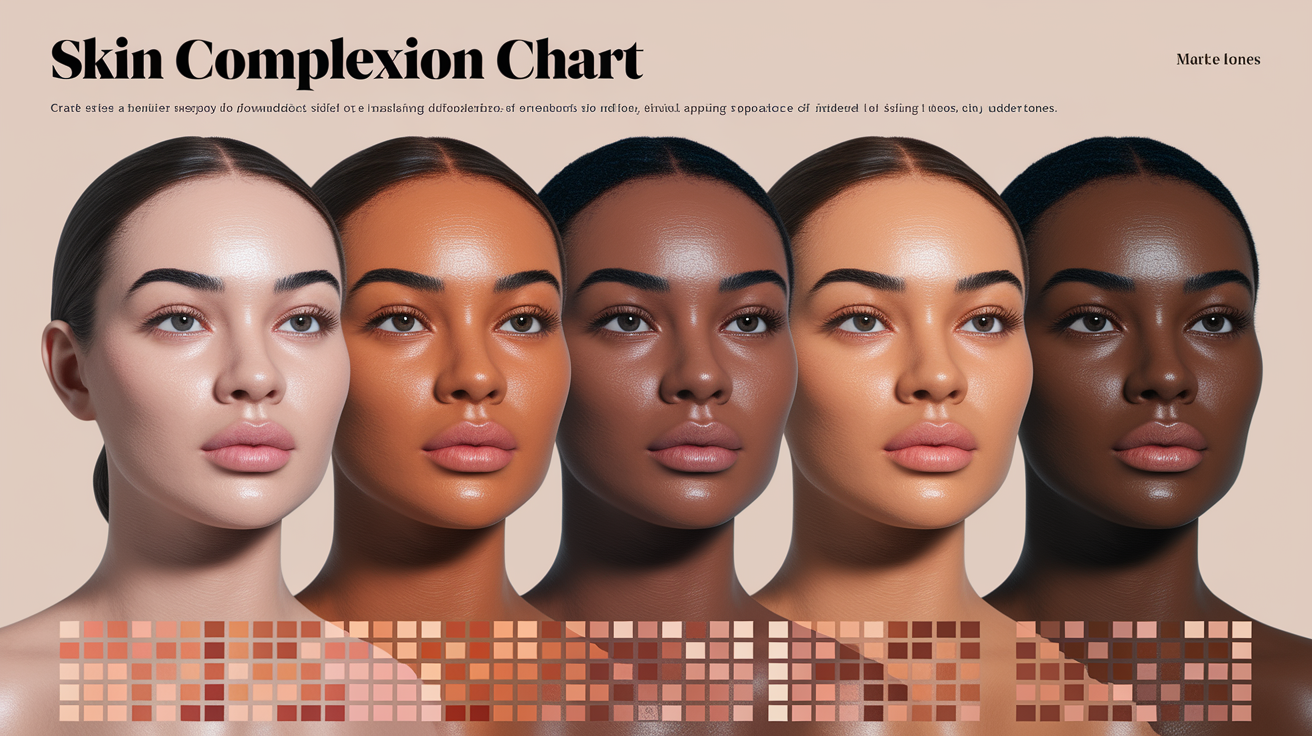
A skin complexion chart is a convenient way to categorize skin by tone and undertone, making selections seem less like a crapshoot. It usually spans fair to dark and links skin color to how it responds to the sun, which aids in care, shade matching, and risk screening.
| Tone Range | Common Undertone | Sun Response | Notes |
|---|---|---|---|
| Very fair | Cool/neutral | Burns fast, rarely tans | High SPF need |
| Fair-light | Cool/warm/neutral | Burns easily, light tan | Redness common |
| Light-medium | Warm/neutral | Burns sometimes, tans slow | Olive may appear |
| Medium | Warm/neutral | Burns rarely, tans well | Golden cast |
| Tan-deep | Warm/neutral | Seldom burns, tans strong | May hyperpigment |
| Deep | Warm/cool/neutral | Rarely burns | Can look cool or warm under bright light |
It lists what you see on your skin's surface (tone) and what lies underneath (undertone). Undertones are generally cool (pink or blue), warm (yellow or golden), or neutral (a transparent mix). This comes into play when you choose foundation, concealer, and even clothes.
A cool undertone tends to pair well with blue-red lips, silver jewelry, and foundations marked with C or P. In contrast, warm undertones shine in coral, olive, and gold jewelry, often using W or Y labels. Neutral undertones can swing both ways and frequently utilize N-labeled base shades, making them versatile for different foundation shades.
The Fitzpatrick skin type chart is a well-known tool that classifies skin by sun sensitivity rather than ethnicity or appearance. It spans Type I (always burns, never tans) to Type VI (rarely burns). This classification can inform SPF habits and suggest risks such as skin cancer and post-inflammatory hyperpigmentation, which is crucial for different skin types.
Another historical system is the Von Luschan's chromatic scale, which was previously used to rate skin color for racial classification. That use is now deemed invalid and unethical, reminding us that charts must serve care, not prejudice.
These tools are often utilized in color analysis. Others sort individuals into seasonal color scales—spring, summer, fall, winter—for clothing and makeup lines. For instance, a warm spring would thrive in pale, warm, clear shades, while a cool winter could shine in deep, cool, high-contrast colors.
It's essential to remember that these charts are a guide, not a law. For optimum shade matches, place a skin undertone chart next to actual swatches and test in daylight on your jaw, neck, and chest. This helps ensure it blends seamlessly without graying, orange-ifying, or appearing ashy.
Constructing a mini color card with reliable base tones, correctors, and fabric swatches can be beneficial. Update it with pictures and journal entries to track your findings. Charts have expanded from 36 to 110 to thousands of hues, yet they continue to overlook subtlety. Use them as direction, and let your eye, lighting, and aims dictate your choices.
The Fitzpatrick skin phototype scale
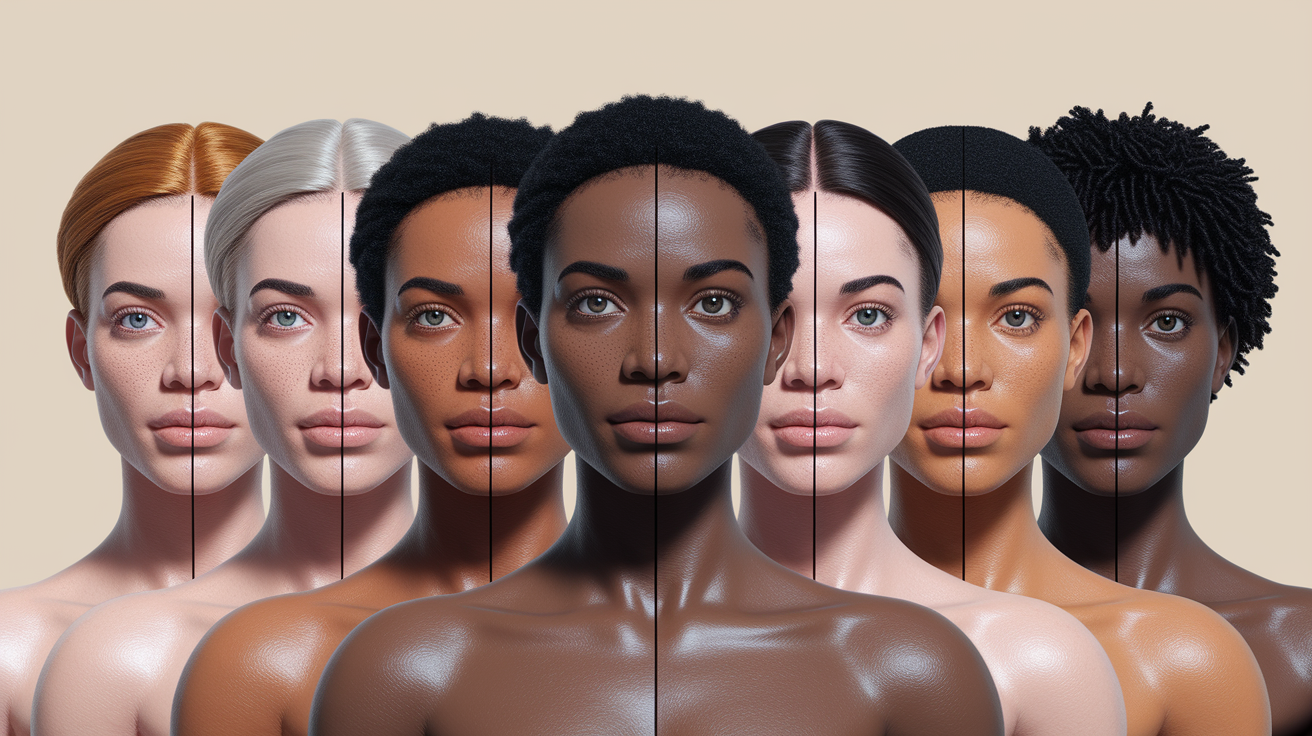
A numeric scale that classifies skin by its reaction to UV light, originally introduced in 1975 by dermatologist Thomas B. Fitzpatrick. It predicts burn risk and tanning potential, classifying skin from 1–6, 1 being most likely to suffer skin damage and 6 least.
It drives sunscreen picks, laser parameters and melanoma risk conversations in clinics. It's the foundation for the five emoji skin-tone modifiers (types I and II combined). Useful, yet imperfect: it has a Eurocentric bent and struggles to reflect the wide global range of pigmentation, even within groups labeled "brown" or "black.
Researchers acknowledge it can misclassify, even white-skinned people, so use it as a starting place, not a complete image.
- Type I: very pale, always burns, never tans, often freckles
- Type II: fair, usually burns, tans minimally
- Type III: beige/medium, sometimes burns, tans gradually
- Type IV: olive/light brown, rarely burns, tans easily
- Type V: brown, very rarely burns, tans deeply
- Type VI: dark brown to black, never burns, tans very easily
When used wisely, it can bolster sunscreen advice (broad-spectrum SPF 30+ everyday), outdoor time planning, and melanoma risk flagging. It remains a staple in dermatology and pigment research, even as new, more inclusive systems are pursued.
1. Type I
Very fair or porcelain, always burns, never tans, typically freckles, red or blonde hair and light colored eyes. Very little melanin = high UV sensitivity and increased lifetime risk for sun damage and melanoma.
Daily SPF 50+, UV-protective clothing, and shade still count on cool or cloudy days. For foundation, apply the chart to correspond very fair colours with cool or neutral undertones and no orange cast.
Build routines around extreme sensitivity: gentle cleansers, fragrance-free moisturizers, mineral sunscreens with zinc oxide, and steady vitamin C for support.
2. Type II
Fair, burns easily, tans minimally. Moderate Melanin, sunburns easily, sometimes mild peeling, gradually tans to light brown.
Opt for mineral or hybrid SPF 50, non-irritating formulas and light-coverage bases that soothe flushes of pink. Use this chart to navigate toward irritation-reducing, barrier protecting skincare.
3. Type III
Medium or beige skin which at times burns and tans to light brown. Extra melanin provides some cushion, but sunburn still occurs.
Pair olive or neutral undertones with a skin tone chart. Test daylight jaw/neck. Apply broad-spectrum SPF 30–50, niacinamide for tone, and lightweight hydrators for combo skin. Reapply every 2 hours outdoors.
4. Type IV
Olive to light brown skin, which rarely burns and tans easily to a moderate brown. A high melanin index provides natural UV protection, not immunity.
Cross-check Fitzpatrick with Baumann skin type chart to tailor care. Look for golden or olive undertone foundations and steer away from pink-heavy options.
5. Type V
Brown skin, very rarely burns, tans deeply, dark hair and eyes. Dark skin's rich melanin resists sun damage, but hyperpigmentation and uneven tone can follow a little UV.
Consult an undertone chart to avoid ashy cast. Lean toward warm or neutral-gold bases. Go for vitamin C and azelaic acid, plus SPF to guard against dark spots. Brands with deeper shade ranges and specific undertones assist with match.
6. Type VI
Deeply pigmented dark brown to black skin, never burns, tans very easily. Maximum melanin provides robust UV protection but remains susceptible to spots and tone shifts.
Consult major-brand shade charts, such as L'Oréal's and pro lines, for precise foundation and concealer matches. Maintain hydration, apply SPF to prevent hyperpigmentation, and introduce retinoids gradually to smooth texture.
How to determine your type

Accurate placement on a skin complexion chart starts with two things: your undertone and your Fitzpatrick skin type. Both steer shade matching, sun care and what colors flatter you.
- Take advantage of natural lighting. Stand by a window in the daytime. Stay away from lamps and screens, they distort color. Check the middle of the face, neck and inner forearm. Observe one base skin color, then the undertone that shines through.
- Determine your undertone. There are three primary undertones: cool, warm, and neutral. Cool ones show pink, red or blue hints. Warm tips toward golden, peach or olive-gold. Neutral hangs in the balance without much of a tug.
Try the vein test on your wrist: more blue or purple suggests cool; more green suggests warm; a mix points to neutral. Hold up plain white paper: if your skin looks rosy or bluish, that's cool; if it looks golden or sun-kissed, that's warm; if it stays balanced, likely neutral.
Olive and neutral complexions can exhibit a combination of blue, green and purple under the skin, so try more than one spot and trust the pattern, not a single look.
- Verify against seasonal groups. Most skin tone charts divide looks into spring, summer, fall and winter. In simple terms: spring (warm-light, clear), summer (cool-light, soft), autumn (warm-deep, rich), winter (cool-deep, high contrast).
Take this to feel which makeup or clothes colors harmonize rather than battle your undertone. If warm, cool-toned products can make skin look grey or flat. If cool, very yellow grounds can become sallow.
- Match your sun response to the Fitzpatrick scale. It's a melanin and skin reaction to UV measurement tool. Type I – always burns, never tans. II generally blisters, tans marginal. III occasionally burns, tans slow. IV doesn't often burn, tans like a charm.
V very rarely burns, tans dark. VI almost never burns, deeply pigmented. Think back: first summer sun, noon exposure, and beach days. If you freckle rapidly and peel, you are probably I–II. If you bronze with ease, you are most likely IV–VI.
Your melanin level influences SPF requirements and the speed at which hyperpigmentation can develop.
- Construct your own color chart. Just create a straightforward table and revise it. Columns might feature undertone, seasonally-specific baseline color, Fitzpatrick type, go-to foundation shades, SPF notes, and shade successes and failures.
Example: Neutral-olive, Type IV, best matches: golden-beige in winter, tan-olive in summer; avoid cool pinks; SPF 50 daily; bronzer needs olive base. This log not only saves time and money, but comes in handy when you're looking for a second opinion or a pro color match.
- Try before you buy. Swatch on jawline, allow to sit 10–15 minutes, then check in daylight. Record oxidizing moves. Match face to neck for a seamless line.
Beyond the Fitzpatrick scale
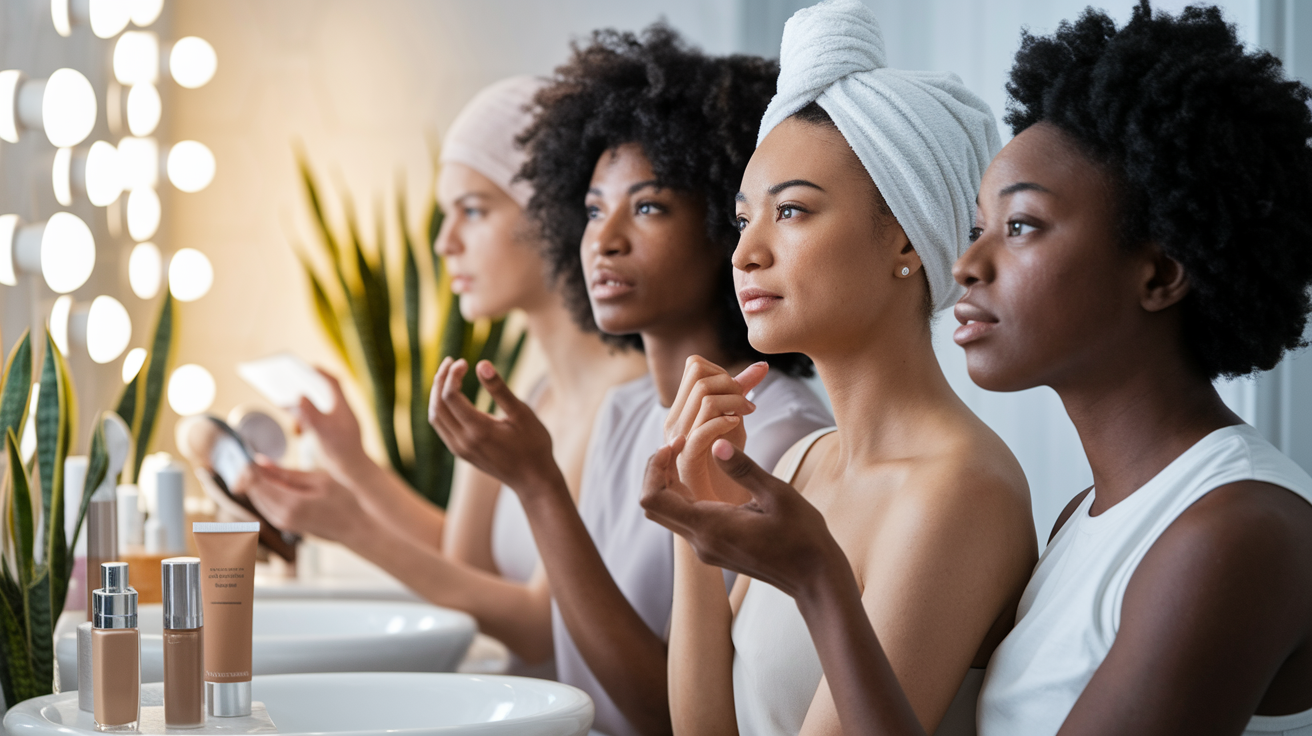
The Fitzpatrick scale remains the default in clinics and research, but it's a poor map of human skin in its entirety. It was constructed around sun response, not quotidian color, and it can overlook subtlety. Research highlights inter-rater differences, overlooks darker shades, and racial bias.
That's where new charts and tools fill the gap to provide a broader, sharper perspective.
Baumann types and undertones
The Baumann Skin Type Indicator sorts skin by four axes: oily or dry, sensitive or resistant, pigmented or not, and tight or wrinkled. It doesn't categorize color as such, but it details why two people with the same tone may require different attention.
A dry–sensitive–pigmented type could patch and darken post-acne; an oily–resistant–pigmented type may scar less but clog more. Combine this with an undertone chart—cool, warm or neutral—based on the hue that peeks from beneath.
Consider what color veins look like in daylight, gold versus silver jewelry and white fabric reflected on the face. Undertones direct shade matches and minimize the trial-and-error cycle that squanders time and dollars.
Examples of added charts and uses:
- Monk Skin Tone Scale: 10+ tone steps for media, AI, and research; improves labeling across deeper browns.
- Roberts Skin Type Classification: blends pigment, sun response, and common disorders; helps triage risk for hyperpigmentation.
- Individual Typology Angle (ITA°): numeric colorimetry from L*, a*, b*; for studies that need repeatable tone bins.
- Munsell or NCS skin maps: hue–value–chroma grids; used in forensic work and device calibration.
- Baumann Indicator: care planning across oil, sensitivity, pigment risk, and aging.
Seasonal color and wardrobe guides
Seasonal color groups–spring, summer, autumn, winter–convert undertone and depth into flattering palettes. It's not fashion dogma, it's a shortcut to selecting shades that don't wash out the face.
A cool-deep (often "winter") skin can glow in genuine red, cobalt and bright white. A warm-medium ("autumn") appears harmonious in olive, rust, and camel.
Apply this concept to cosmetics, sunglasses, scarves and hats. Test in daylight by holding fabric or digital swatches up to the face and seeing if shadows or dull tones cast.
Colorimetry and AI for precise ID
Contemporary colorimetric charts utilize spectrophotometers to read skin in L*, a*, b* values with reproducible metrics in mm2 areas. Coupled with machine learning, these readings classify tone with better accuracy and balanced accuracy than human raters, particularly when mapped to Monk scale steps.
Research demonstrates AI can mitigate the bias and noise inherent to Fitzpatrick, which is often scientifically tenuous. In clinics and teledermatology, this tighter mapping can enhance diagnosis, flag dangers such as post-inflammatory hyperpigmentation, and monitor treatment across populations with less bias.
Why your skin type matters
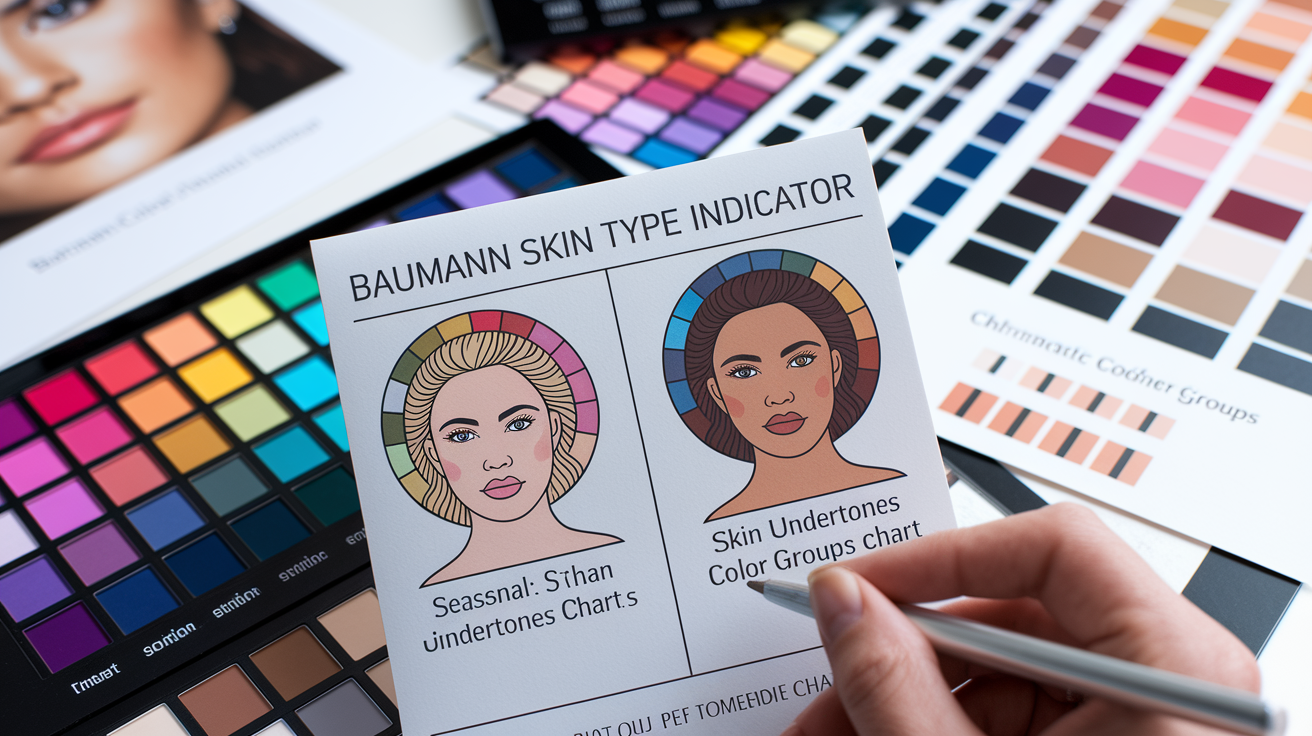
Skin complexion charts capture tone and undertone, but they perform optimally when combined with a straightforward read on skin type. That blend guides skin undertone matches, skincare decisions, and overall skin wellness through seasons and life phases.
Your skin type and undertone matter for a perfect makeup application and foundation color. Undertone is the stable shade underneath your skin (cool, warm, neutral), while skin type is how your skin acts day to day (oily, dry, combo, normal, sensitive). If you have oily skin with a warm undertone, a matte, oil-absorbing foundation in a warm-golden range will hold better and look true.
Dry skin with a cool undertone generally requires a moisturizing, satin base with pink/rosy tones. Mess up one or the other and it can go gray or orange or patchy. Try along the jaw in natural light, wait 10 minutes and observe if the shade remains even, without oxidizing. Layer lightly and establish only where you glow to maintain the fuse clear.
Depending on your skin type, your face demands different care. Oily skin gets acne and clogged pores easier, so seek out gentle gel cleansers, salicylic acid (0.5–2%), light moisturizers and non-comedogenic sunscreens. Dry skin requires cream cleansers, ceramides, glycerin, and lots of moisturizing, morning and night.
Sensitive skin loves short ingredient lists and patch tests. Fragrance-free sunscreens with zinc oxide can work wonders. Combination skin can split the face: a clay mask on the T-zone and a richer cream on the cheeks. Your skin type can shift as a result of hormones, stress, diet or climate, so re-evaluate each season.
Oily skin products on dry skin can strip and sting. Heavy balms on acne-prone skin can clog. Adjust actives by need: niacinamide for oil balance, azelaic acid for redness and pigment, retinoids for texture and fine lines, with slower use on dry or sensitive skin.
Pairing complexion products avoids patchy tone and blotchiness. Match concealer undertone to foundation, applying peach/orange corrector only where shadows peep through, then a thin covering of foundation to maintain the dimension authentic. Dust lightly with powder and select a shade that won't shift undertone.
Your bronzer should mimic your undertone – warm skins fit golden-brown shades, while cool skins tend to neutral-taupe shades. Use skin type charts to reduce sun damage, prevent hyperpigmentation, and promote resilient skin. Daily SPF 30+ is a must for all types, reapply every 2–3 hours outdoors.
Consistent moisturizing is important for any skin, as a robust barrier can minimize irritation and pigment inciters. Figure out your triggers–heat, scrubs, scents–and avoid. This is crucial to ward off flares and to protect against pre-mature aging from UV and inflammation.
The future of skin analysis
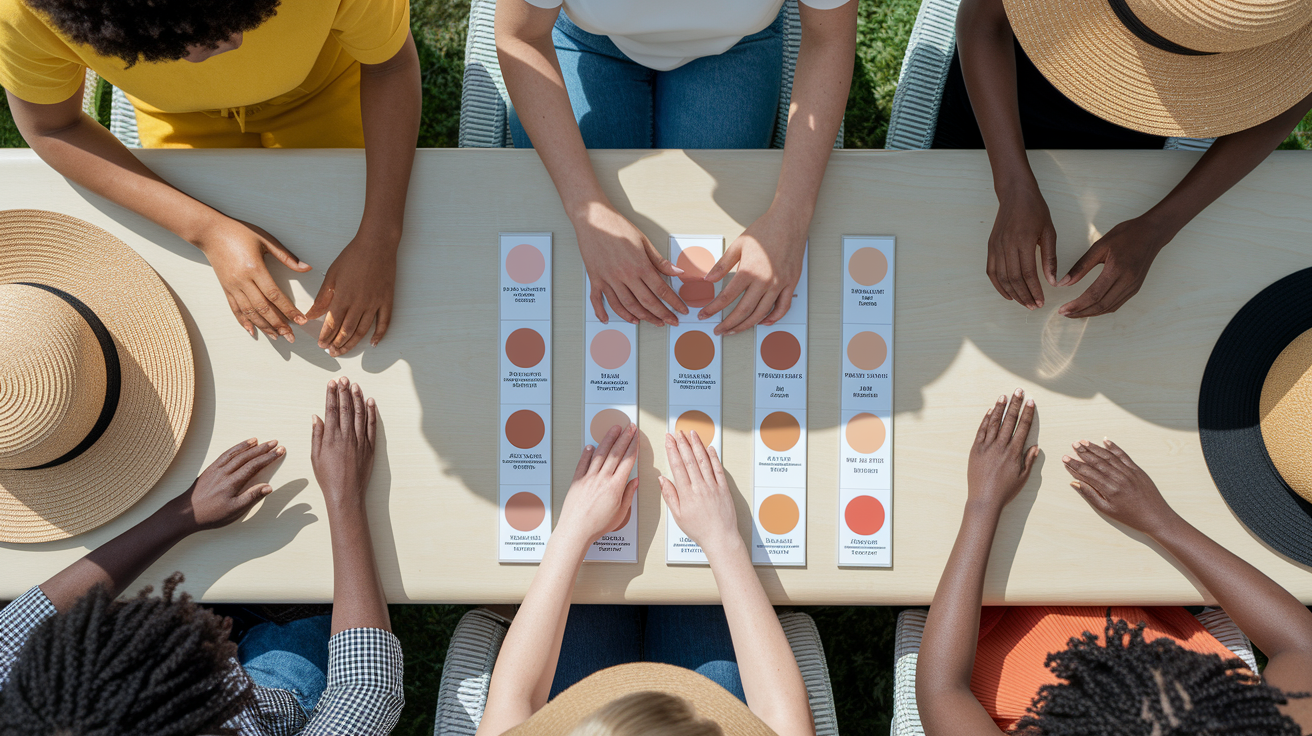
Complexion charts are only as good as the technology and data behind them. What's next combines more accurate measurement with more equitable systems — so people of all skin tones receive precise readings, improved treatment, and improved shade matches. This is particularly important for accurately determining the right foundation shade for each individual's unique skin undertone.
| Anticipated advancement | What it is | Why it matters | Expected impact |
|---|---|---|---|
| AI tone mapping with Monk scale | Algorithms trained to classify tones and undertones using the Monk scale and similar detailed charts | Finer groups mean fewer mismatches and more equity | More precise shade matching across deep, medium, and very light tones |
| 3D body scans + AI images | Full-surface scans and AI renders to study tone shifts and lesions | Catches patchy pigment, scars, and risk spots early | Better tracking of melasma, vitiligo, and sun damage |
| Multimodal sensors | Computer vision, spectroscopy, and thermal data in one read | Helps see through makeup, light glare, and noise | Cleaner reads at home and in clinics |
| Bias-aware machine learning | Datasets balanced for darker skin and varied undertones | Cuts error rates that often hit deep tones | Fairer results used in diagnosis and beauty |
| Digital micro-changes | High-res imaging that flags small tone and texture shifts | Early signal of acne flares or eczema | Sooner care with simpler treatments |
| Personalized plans | Models that link skin reads to care steps | Less trial-and-error and wasted spend | Routine advice tailored to your skin and climate |
Mobile apps and smart devices are transitioning from entertaining toys to practical assistants. Camera-guided apps already test color balance and light and then scan cheeks and jaw in seconds, making them invaluable tools for selecting makeup that complements various skin types.
Paired with a match card or neutral grey patch, these apps read undertone—olive, golden, cool rose—more clearly. Smart mirrors and phone clips illuminate controlled LEDs to replicate noon sun or soft indoor light, ensuring your undertone doesn't change with the room, which is crucial for achieving the perfect foundation match.
Pair that with an inexpensive spectrometer dongle, and the app can read diffuse reflectance to track hemoglobin and melanin trends over weeks. This forces brands to develop broader, more intelligent shade systems, particularly for deep skin tones and those with a neutral undertone.
Think inclusive foundation lines that code for depth, undertone and overtone, with mineral bases that embrace sensitive skin and minimize cast in photos. Shade finders will employ Monk scale labels and AI tone clusters to organize shelves and minimize guessing online, with try-on previews that maintain color-accuracy under varied lighting.
Dermatology will keep up. Larger, more diverse image banks and bias tests embedded within machine learning pipelines can improve accuracy for darker skin tones, where disparities have been significant, ensuring that everyone can find their perfect match.
When computer vision, spectroscopy, and clinical history unite, systems can flag when the first signs of melanoma or post-inflammatory hyperpigmentation or rosacea appear. They can then advise next steps with transparent probabilities and simple language, enhancing overall skin care.
Over time, these tools feed back into better charts, better training, and better care standards worldwide, ultimately promoting global skin color diversity and inclusivity in beauty products.
Conclusion
To end, a skin complexion chart provides defined language and a common map. The Fitzpatrick scale provides a foundation. Shade, tone, and sun response are more revelatory. Simple checks help a lot: note burn or tan after 30 minutes in midday sun, match to a shade in good light, test with a mild product patch for 24 hours. Real life confirms it! Racer in high UV zones noticed less sun spots post daily SPF 50 + cap. A chef in hot kitchens softened flare-ups with a light gel and a bland cleanser.
Ready to give it a shot? Choose your probable type, record what you observe for a couple weeks and then adjust care and SPF. Have a question? Ask me.
Frequently Asked Questions
What is a skin complexion chart?
A skin complexion chart is a guide that classifies skin by tone, undertone, and sun exposure. It aids in matching skincare, sunscreen and cosmetic shades. The Fitzpatrick scale is the most commonly used chart for sun sensitivity and pigmentation risk.
What is the Fitzpatrick skin phototype scale?
The Fitzpatrick skin type chart is a six-type scale (I–VI) based on how your skin burns or tans. I always burn and never tan, while VI never burns and is deeply pigmented, aiding in predicting sunburn risk.
How can I determine my Fitzpatrick type at home?
Evaluate your natural hair and eye color, base skin color (unexposed areas), and sun sensitivity to determine your fitzpatrick skin type. Do you burn, tan, or both? Utilize a trusted online quiz, then verify with your derm.
Why does my skin type matter for skincare?
With your skin type charts guiding SPF requirements, active strength, and pigment care, lighter skin tones require rigorous UV defense to avoid burning. Dark-skinned types need UV protection to stave off hyperpigmentation, ensuring proper care enhances effectiveness.
What's beyond the Fitzpatrick scale?
Newer tools, such as AI imaging and genetic risk models, enhance the accuracy of analyzing skin tones, including melanin content and erythema index, providing individualized treatments beyond the traditional Fitzpatrick skin type chart.
Can the Fitzpatrick scale predict laser safety?
It assists, but it's insufficient. Device type, wavelength, fluence, cooling and your recent sun exposure are factors. Never underestimate the power of a trained clinician to patch-test and dial in settings for your unique skin and concerns.
How often should I reassess my skin type?
Reassess yearly or when life changes, such as new climate, pregnancy, or increased sun exposure, as your skin type may shift. Periodic check-ins ensure your sunscreen and complexion products align with your evolving skin tone.